#Symmetrical Art Radial
Text
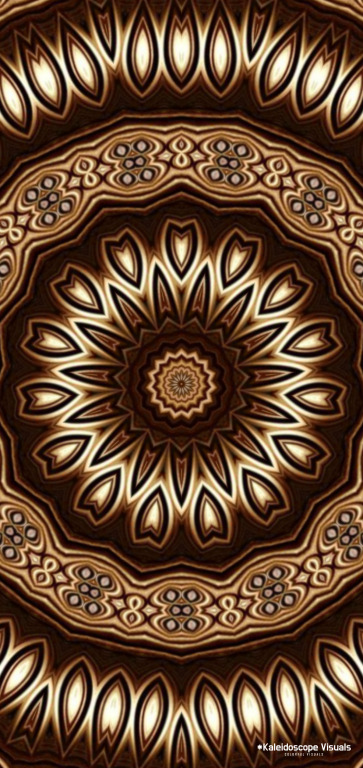
Visit YouTube 📺 Kaleidoscope Visuals Channel
#art#symmetryart#symmetrical#symmetricalart#radialbalance#artwork#abstract#kaleidoscope#digitalart#kaleidoscopeart#abstractart#kaleidoscopevisuals#Symmetrical Artwork Project#Symmetrical Art#Symmetrical Art Design#Symmetrical Art Design Inspiration#Symmetrical Art Design Pattern#Symmetrical Art Balance#Symmetrical#Symmetrical Art Radial#Symmetrical Art Rotational#Symmetrical Art Project
2 notes
·
View notes
Text
youtube
📺 Kaleidoscope Visual Classical Romantic Acoustic Piano Music 4K Kaleidoscope Visuals Art Video
Digital kaleidoscopes are computer programs that create kaleidoscope patterns. These programs can be used to create an endless variety of patterns, from simple to complex. Digital kaleidoscopes can also be used to create animated patterns that move and change over time.
#romantic music#pianomusic#art#artwork#abstract art#circular art#kaleidoscope#kaleidoscope visuals#万華鏡#symmetry#patterns#kaleidoscopeart#digitalart#kaleidoscopevisuals#Youtube#Symmetrical Art Design Inspiration#Symmetrical Art Design Pattern#Symmetrical Art Balance#Symmetrical#Symmetrical Art Radial
4 notes
·
View notes
Text

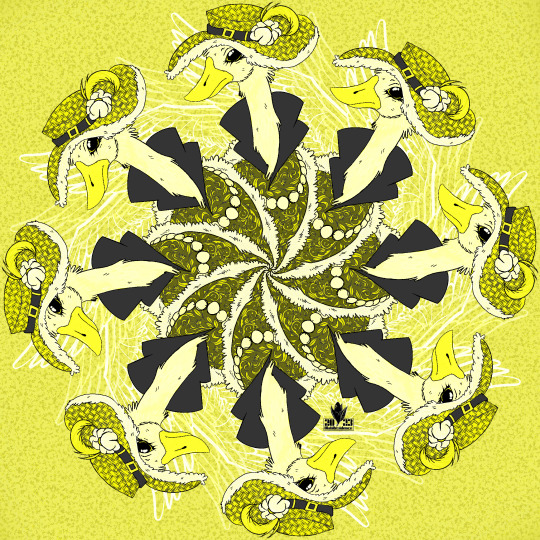


Huevember but I do it months in advance and they're all monochromatic part Yellow:
1 - Yellow Umbrella
2 - Victorian Geese
3 - Sunfloral
4 - DeadMoths
#huevember#yellow#monochoanitic#mandala#radial design#radial art#radial symmetry#symmetrical#umbrella#goose#geese#victorian goose#sunflower#death's head#hawkmoth#tw insect#tw insects#procreate#procreate app#procreate art#artists on tumblr
5 notes
·
View notes
Photo
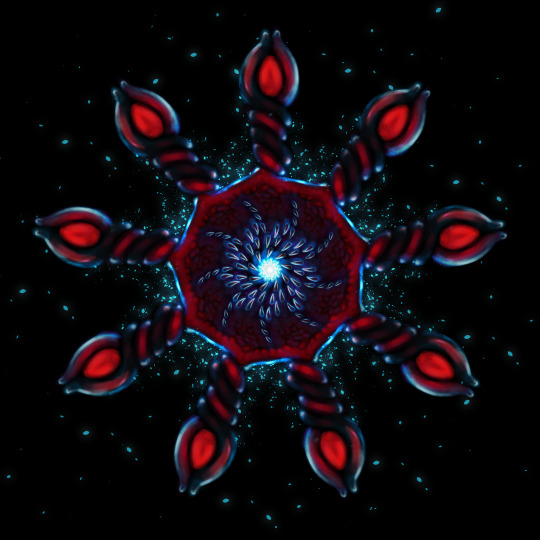
21 notes
·
View notes
Text
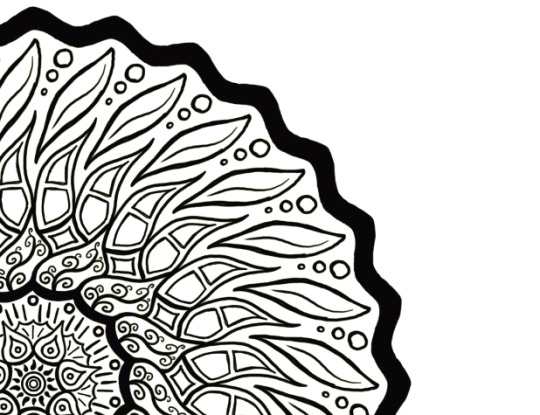
Started a new digital piece, initially I was gonna make a set of printed holiday cards since I knew I couldn't finish the traditional ones in time, but life really got in the way so now this is just a standalone piece.
I've had it sketched out for weeks, so all it needs is lining, colouring, and finishing.
#art wip#artists on tumblr#mandala#more like inspired by mandalas but there's no other word to use for it yet#'radially symmetrical primarily geometric design' doesn't really roll off the hypothetical tongue...
4 notes
·
View notes
Text

horse
#psii.txt#my art#my ocs#horse#speculative biology#creature design#Cataclysm#Harper#I'm still working on the 'horse' s design#it's supposed to look a bit more llike it was once radially symmetrical#btw harper doesn't wear a cowboy hat in canon I just gave her one for fun here
3 notes
·
View notes
Text

Some critter art of Ogninda.
Planet's mega fauna is equally slimy and there are many small lurkers everywhere. Including actual slimes, which are starfish-like radially symmetrical critters with a large and many layered protective coat of slime.
278 notes
·
View notes
Text
The Six Lords of Ko-ve-dor, and an introduction to my friend's project Star Odyssey

One last art piece to end the year on a high note. It's an entry @jennywolfgal's sophont in her sci-fi / spec-evo / worldbuilding project Star odyssey. A far future where humanity and a few other advanced species help to found a Galactic Coalition of Worlds spanning half the galaxy. Everyone go follow her and check out her project!
I genuinley consider this atm my magnum opus in every aspect, Linework, Texturing, Coloring, Composition, and ESPECIALLY rendering.
The Commonality of Ko-ve-dor is an alliance between multiple sophont species evolving side by side on the same planet. All working together towards the prosperity for all denizens of the known galaxy.
Planet Ko-ve-dor, also known as Kepler-442 B, is a super earth in a 3 planet star system all orbiting a K-Type main sequence star known as O-uosa. Ko-Ve-Dor’s higher mass, larger magnetosphere, denser atmosphere, 3 moons, larger continents and O-uosa’s longer lifespan make Ko-ve-dor a superhabitable world. Capable of hosting more biodiversity than our own earth for a far longer time.
Plantlife on Ko-Ve-Dor is just as complex as it’s animal life and it shows. Most terrestrial flora possess a segmented exoskeleton that vary in shape and size akin to an insect. Most forms of plantlife exhibit both radial and bilateral symmetry in their overall body plan. Some species of Ko-ve-dor plantlife can even take in their surroundings with special segments that act as one big sensory organ.
And aside from some greenish phytoplankton, most flora on this world take on a red pigmentation to make the most out of its star’s dimmer light.
Not only is Ko-ve-dor more biodiverse than earth. But it’s greater abundance of life and more surface area means there's far more consumable biomass too. Allowing it’s animal life to reach greater heights and the option for greater brainpower. This paired with evolution’s trend towards more socialization. Means that sapient life has developed not once, or twice. But six times, all within a similar enough time frame for them to all interact with one another.
As each sophont species is a good representative of Ko-ve-dor’s kingdom of life. We will be skipping over the planet’s animal life to discuss their biology.
The Dor-Eø are the largest of the six sophonts and represent the planet’s many soft-bodied invertebrates. They take on a body plan very similar to earth’s flatworms. And being filter-feeders, they fill a niche not too different from whales. Their large carpet-like fins are actually enlarged partially external gills to aid in respiration. And they manipulate their environment with their two mitten shaped mandibles and opposable tusk thumbs.
They live in tight-knit nomadic pods where they ride the waves in search of plankton. They hunt said plankton like dolphins, continuously switching roles to either shepard the plankton and strike the condensed schools. And as they achieved sapience they’ve built nets to catch more plankton and dorsal fin flags to distinguish which pod they’re apart of.
The Dor-Ssri’ii represent a sapient species of aquatic, radially symmetrical fish analogs. They possess twelve eyes, with three on each side, a four sided jaw, and eight fins, four anterior fins and four posterior fins. Their intricate color palette helps them blend in with the yellow and red reefs.
They live in borderline eusocial schools where they manipulate their environment through their mouth like a tuskfish
The Ko-Ka’Kta are terrestrial relatives of the Dor-Ssri’cai, these are a sapient species of para-reptilian pack hunters native to the deserts and shrublands of Ko-ve-dor. They retain their radial symmetry and are quite basal compared to their relatives. Their forearms have atrophied into small rudders used by females to attract mates and live in matriarchal packs.
And they manipulate their environment with four highly specialized tongues. Their lack of claws or fangs pushed them to crafting an array of weapons to hunt. That and their hierarchical pack structure paved way for sapience
The Ko-A’atur represent the most derived group of Ko-ve-dor’s Vertebrates. Descending from a group that forgone their radial symmetry and became secondarily bilateral. Their heads hyper-elongated to the point where it’s now two separate body parts all together. Their lips have pulled back and became large flaps to cool off and express emotions.
Of all the sophonts they live the least socially, They forage and occasionally hunt in groups of 3-5 individuals. But the social bonds formed are so tight and complex that it managed to bring them up to sapience.
Onto life in the sky. The Ve-Huik are one of two representatives of Ko-ve-dor’s aerial invertebrates. They are a species of hexapodal invertebrate flyers protected by a sturdy exoskeleton. They fill a niche similar to parrots, capable of crushing nuts and fruits with their large mandibles that clench together like a fist. They live in small flocks and communicate by short whistles and hums. And they manipulate their environment with their remarkably dexterous six legs.
And lastly the Ve-Z’qi, a Is a seafaring relative to the Ve-huik, they are a sapient species of flying arthropod analogs native to the many coastlines of Dorveko. They live in nomadic flocks, hopping from island to island. They hunt their aquatic prey by looking for disturbances in the water before diving in to catch their target
Their history is one defined by sheer first contact and a long road to equality. The Dor-Eø and the Ve-Z'qi,a were the pioneers of exploration due in part of their nomadic lifestyles giving them a global range to freely explore. Slowly each species would suddenly learn the existence of their contemporaries and how to work with them.
Their society is egalitarian and very xenophilic, each species is born with full citizenship and everyone regardless of origin and identity are treated truly equally. yet their government is surprisingly autocratic. Each planet is ruled by a handfull of philosopher kings and queens who come from all walks of life. And are chosen by the state based on their view of life and understanding of the humanities. All to improve the lives of their people. They are also very welcoming towards outsiders, and have made themselves a beacon of liberty and safety for the galaxy's downtrodded.
With so many different sapient minds at work in a society that promotes harmony and teamwork. The Ko-ve-dor Commonality has advanced rapidly, being able to become a spacefaring civilization a thousand years before mankind. Their architecture and spaceships are large and bulbous, containing vast aquariums and spacious domes to accommodate all the different lifestyles. And have become one of the Galactic Coalition of Worlds' most important members.
Depicted here is a human diplomat posing with a friend group eager to take a photo with an unfamiliar face.
I'm happy i managed to get this out before 2024, though there still maybe work to be done, mainly to expand on their worldbuilding, and i hope everyone else has a happy new year!
#my art#artist on tumblr#art#speculative biology#worldbuilding#alien species#speculative zoology#xenobiology#Jennywolfgal's Star-Odyssey
161 notes
·
View notes
Text
I wanted to do a little shitposting today with my recent bug photos, but something more important needs to be said before people assume too much. I'm an awful procrastinator, but I'd better not hold
Just to make some things clear (cause I found some of you guys talking about that): I checked out Simon Roy and his Amphorans project and no, I didn't reference his sophonts specifically. But I did use one image as a reference and it was the one with a horizontal animal (also designed for his project) which I found on Pinterest when I wanted to make more a suitable body plan for horizontal terrestrial life. In fact, I liked that someone had similar ideas! When I was drawing beacons for the first time, I used insects and crustaceans as refs combined with my intention to make them look less rough and more fuzzy because I adore fuzzy aliens. I won't say I've never seen any of Roy's other amphorian art though. They look faintly familiar to me, so I might have stumbled upon them several years ago when I used to consume tons of content daily and forget everything on the next day. I don't remember. But as I've just said, I've never used them as references intentionally and the amphorian blog was not known to me til recently.
It's my first time posting art on Tumblr and I don't want to be associated with plagiarism so can I totally try reworking my species and make it less similar. I have a lot of info about their biology (like why their third antennae isn't used in manipulation and cannot be seen outside at all, how they give birth and grow), culture, food habits, families, language (especially how they breathe while speaking) and some kind of script, and even how perception of femininity and masculinity varies between cultures. All of that I haven't posted yet because I have nothing to illustrate all this stuff with. If I really need to rework the stuff, I can do this, it's fine, just tell me. But it's gonna take time
Also the exact pin with the image that I used:
34 notes
·
View notes
Text
can we take a sec to appreciate the weird, kind of alien pokemon designs out there
Like, sure, there's a bunch of pokemon designs that are really cute/cool and all, but I feel like there isn't enough love for the more bizarre designs out there and I really wanted to take a closer look at them.
I think Metagross is a more popular pokemon out of the bunch I'm going to be looking at, but have you ever considered just how weird its design is?
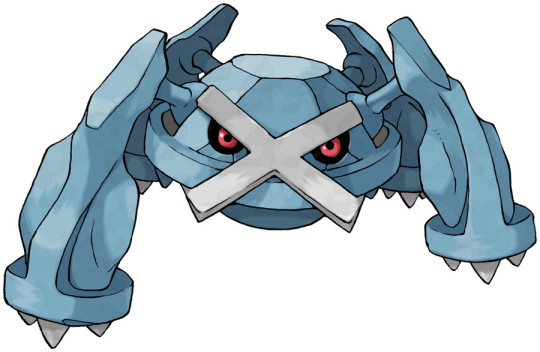
Like... where do I begin here. The legs are so strangely organic looking, with folds and bulges that mimic leg anatomy despite the rest of the design being so rigid and hard-surface. It's this bizarre blend of organic and inorganic that just makes this design truly *feel* alien and strange. The joints look like ball and socket joints on a plastic toy which further makes its design a little surreal to me.
The striking red eyes under that big metallic cross makes its face even more distinct and menacing, sort of like a threatening display, or like, substantiating that feeling that this robotic creature is an unrelenting wall that won't let anything pass it.
The overall radially symmetrical design of Metagross is also really interesting to me. They could've made metang's final evolution look like a more traditional humanoid robot with big metallic arms and instead of 2 more arms it got 2 big legs (kind of similar to Golurk actually), but instead they went for a, kind of disc shaped design that looks far more like a strange alien spider. The big ring around its body makes me think of toy tops or like even a UFO to continue the idea of this being some alien creature. Truly fascinating and I am really really glad they went with this kind of design.
Let's move on to another pokemon that admittedly has very similar vibes to Metagross, Ferrothorn

Ferrothorn is another pokemon with a radially symmetrical design. It is based on prickly seeds that stick to fur and clothing, and they went for a design that feels almost like an echinoderm like a sea urchin. Its body is round and vaguely disc shaped once again, kind of giving UFO vibes, and instead of bulky robotic arms like Metagross, Ferrothorn has these massive vines that sprout from the top of its head, giving it a really unique design with a lot of potential.
The vines sprouting from the top of its head is very clearly inspired by how they would actually sprout out from a seed, but it also suggests that Ferrothorn is mainly adapted for climbing on the rooftops of caves and kind of swinging around as its spiky arms clasp onto the rocks above. Perhaps it takes down aggressors or prey by rooting its arms into the top of the cave or nearby stalagmites and then slamming its massive thorny body onto them.
Now I want to talk about Dhelmise, which I believe isn't really that popular. There isn't a lot of art of this fella and that's a shame because the potential is insane for this concept.
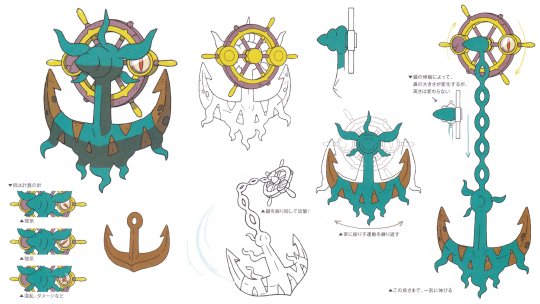
I think people sleep on this fella a bit too much. Sure, it's just a wheel and anchor, but there's so much more to it. One little detail I like is that the wheel has a compass on it that looks very much like an eyeball which gives truly gives it the feeling that it's a live, sentient creature and not just a shipwreck. But what I really want to talk about is the seaweed.
Dhelmise is actually the seaweed that's enveloping the abandoned wheel and anchor, explaining its grass/ghost typing. It's this bizarre species of seaweed that sort of possesses these ship remains and uses it as a vessel as it moves about. What appears to be a chain isn't even a physical metal chain wrapped in seaweed, it's *just* seaweed that's probably tightly bound and shaped to kind of resemble a chain, which I assume is the main body of the creature.
Just imagining Dhelmise rising from the ocean and just swinging its massive chain and anchor around a wailord (something it has been described doing frequently in pokedex entries) and then just dragging it down below the ocean is such a menacing thought. Perhaps they are arbiters of whalefall ecosystems, and they drag Wailords to the sea floor to then feed off its decaying remains alongside countless other benthic pokemon. Maybe they nourish seabeds with young Dhelmises who haven't yet taken a host with Wailord remains they have hunted before they are ready to possess an anchor.
Do you ever wonder if they actually go out of their way to ambush human ships to create shipwrecks and that's how they procreate? Are there nautical legends of possessed anchors and wheels rising from the seas and attempting to sink their ships? It's a chilling idea.
#pokemon#i just really wanted to talk about these pokemon and these designs#especially Dhelmise I feel like its wayyyy underrated#long post
7 notes
·
View notes
Text
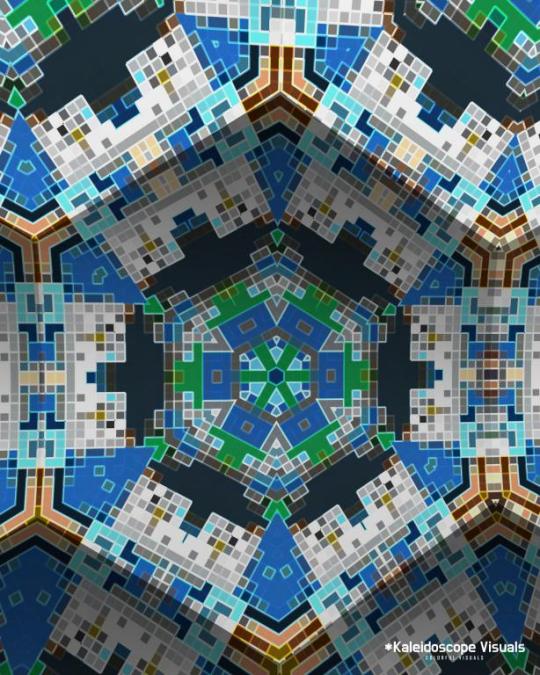
Watch @ YouTube 📌 Collection of best kaleidoscope 4k music video
#art#artwork#abstractart#symmetryart#kaleidoscopevisuals#kaleidoscope visuals#kaleidoscope#kaleidoscopeart#digitalart#creativity#abstract#harmony#kaleidoscopic radial art#kaleidoscopemagic#Kaleidoscope Art#Kaleidoscope Retro#Kaleidoscope Video#Colorful Abstract#Kaleidoscope Vision#Symmetrical Art Radial#Symmetrical Art Rotational#Symmetrical Art Project#Symmetrical Art Pattern
0 notes
Text
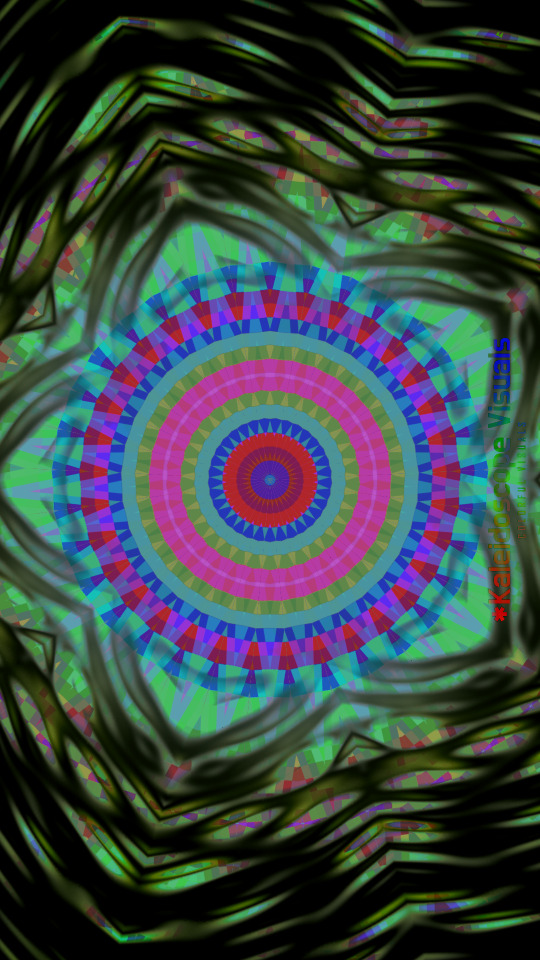
📌 📺 Symmetrical Pattern, Kaleidoscope Visual with Ambient Music, Radial Symmetry Art, Abstract Waves
#art#artwork#abstract#kaleidoscope#digitalart#kaleidoscopeart#abstractart#kaleidoscopevisuals#Kaleidoscope Visual Art#Symmetrical Pattern#Kaleidoscope Visual with Ambient Music#Radial Symmetry Art#Abstract Waves#symmetricart#Symmetrical Art Balance#Symmetrical#Symmetrical Art Radial
2 notes
·
View notes
Text
Composition Seminar
I watched the Composition Seminar on Moodle to help me with arranging my prints. Composition is the spatial relationship between all parts of an image.
The composition is a key factor in art that determines an image’s look, feeling, message and meaning. It is the arrangement of all the visual elements e.g line, negative space, positive space, texture, colour and pattern to create a harmonious and coherent piece.
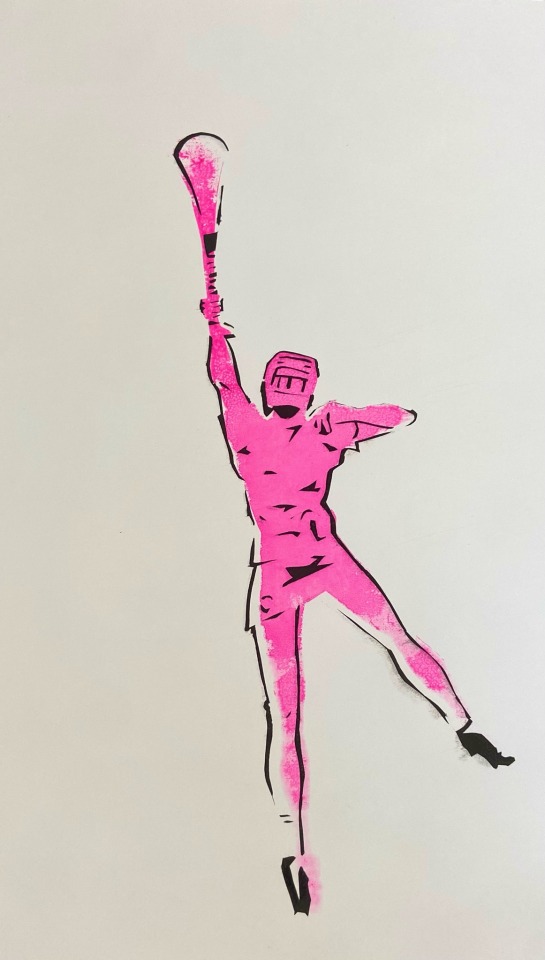
For example- I cropped this print so that there was an even amount of negative space around the figure. I also placed them to the bottom right corner, meaning your eye is drawn to them.
The Structural Elements of Composition
- Balance- radial, symmetrical or asymmetrical
- Emphasis - the dominant part of the artwork
- Harmony - how the elements work together to form a piece.
-Movement - causing the eye to move over the work
- Unity is the ( the combination of elements as a whole), pattern, rhythm, space and proportion.
- Coherence- analogous colour and colour tonality. Also achieved through similarity of colour, size and texture.
Analogous colours are colours that are grouped close together on the colour wheel. Eg. Blue and Green
The scale of something and the surface that you use all have an impact on your art work.
Point of attraction- light can bring the eye to focus on a specific object or person.

In comparison, I cropped this picture so the figure touches the edges, this gives the impression they are trapped within the page.
3 notes
·
View notes
Photo
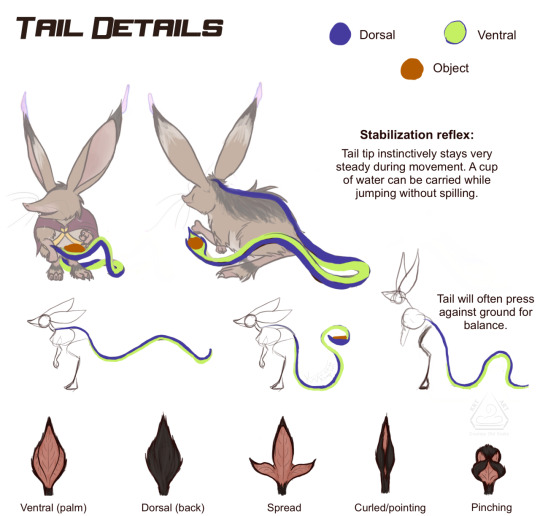
Tellurian Tails | 6-24-22
[Image description: Concept art exploring the function of the tail in a jerboa-like alien design. The tail is used for both balance and grasping objects. Its prehensile tip has a spade-shaped muscular hydrostat. Detailed transcript below cut. End ID.]
.
A closer look at tellurian tails! I’ve taken inspiration from the way jerboas use their tails, spider monkeys, and stable chicken heads.
(These illustrations are all mine, but I commissioned some sketches from @bethdehart to help me sort out some design details before I got to this point! They had the very fun idea of splitting the tail tip so that it would have multiple graspers; I adapted their idea from a symmetrical radial design to something more thumb-like, because I was still attached to my original leaf-shaped concept. xD)
.
Transcription:
Stabilization reflex: Tail tip instinctively stays very steady during movement. A cup of water can be carried while jumping without spilling.
Tail will often press against the ground for balance.
Detailed image description:
The tellurian is a bipedal mouse-like creature with very long ears, a very long tail, and digitigrade kangaroo-like legs. It has glowing whiskers and a stiff glowing structure at the tips of its ears.
The tail is furred everywhere except the ‘palm’ of its grasping tip. Its grasping tip has one main central lobe, plus two smaller lobes on either side. In a relaxed position they are held together into the general shape of a lobeless elliptical leaf with a pointed tip. They spread apart into a trefoil shape, and can curl closed or touch tips to tips.
The palm of the tail faces down towards the ground in its neutral position, but the tail can be twisted so that the palm faces upwards as well.
#creature design#speculative biology#rodents#jerboa#aliens#digital art#finished art#sketches#taking the long way#krtart#tellurians
28 notes
·
View notes
Text
ELEMENTS (7)
POINT - A point is the visual element upon which all other elements in a composition are centralized. Points and lines are used to create more complex shapes, and in design, they’re often used to direct a viewer’s attention towards a certain area in an image.
LINE- A line is a geometric element generated by a moving point that has extension along the path of that point. Lines can be curved, straight, or both. They can be solid or dashed, implied or psychological.
SHAPE- Shapes are 2-dimensional and can be measured by height and width. Shapes can be the outline of an object, and sometimes, the shape of a familiar object can become unfamiliar depending on the photographer’s perspective. In photography, the silhouette is the most recognizable type of shape.
FORM - As opposed to shape, form is 3-dimensional. It has height, width, and depth. It can be organic or geometric, and like shapes, forms create positive and negative space. When a form is captured by a camera, it becomes 2-dimensional; we differentiate forms from shapes with shadow.
TEXTURE - A texture refers to the visual or tactile surface characteristics of something. Texture can be smooth, rough, slimy, bumpy, etc. Like form, texture in photography is 2-dimensional and is revealed by variations in value. Smooth objects may have reflections, while rough objects may have highly contrasting areas of lights and darks.
COLOR - Color is a phenomenon of light or visual perception enables one to differentiate otherwise identical objects. Color can also be defined as a specific combination of hue, saturation, and value. Light alone has no color, but when you direct it through a prism or water, it separates into bands of color that form a rainbow.
SPACE/DEPTH - The depth of a scene relates to its size and the space within it. Most photos have a foreground, middle ground, and background; the clearer the boundary between these grounds is, the more depth an image will have. Additionally, space can refer to the use of an area within a plane, such as positive/negative space.
PRINCIPLES (8)
VARIETY - Adding variety to an image keeps it from becoming monotonous. Artists utilize variety by placing contrasting elements close to each other: bright colors next to muted or lighter colors, text next to images, organic shapes next to geometric shapes, and so on.
EMPHASIS - Emphasis is used to focus a viewer’s attention onto a specific area of an image. An artist can accomplish this by adjusting certain elements, such as line or color, so that they help make one part of a composition stand out more than the rest.
BALANCE - Balance creates visual harmony and prevents an image from feeling too chaotic to the viewer. A balanced image is one that holds the same amount of weight on either end; for example, one “heavy” big object on one side, and multiple “light” little objects on the other. Asymmetrical, symmetrical, and radial are the three types of balance that artists can utilize in their artwork.
SYMMETRY - Symmetry refers to a piece of artwork that mirrors itself on either side, or around a point (called radial symmetry.)
MOVEMENT - In art, movement refers to elements of a composition arranged in a way that encourages the viewer’s eye to take a certain path as they look at the image. An artist can guide the viewer’s eyes through use of line, shapes, and colors to encourage a specific way of seeing the artwork.
PATTERN - A pattern is composed of numerous different elements repeated in the same way within a composition. Colors and shapes are often the main elements used in the creation of patterns.
RHYTHM - Rhythm gives an art piece a feeling of action through the repetition of lines, shapes, and colors that creates a flowing path for the eye to follow. Random, regular, flowing, and progressive make up the different types of rhythm. Rhythm is what encourages a viewer’s eyes to traverse the entire piece, rather than staying in one place.
UNITY - Unity adds a sense of wholeness to a piece of art through the careful placement of elements that creates a harmonious composition.
1 note
·
View note
Text
A Deep Dive into the Essence of Design – Unveiling the Core Tenet of Balance

Upon entering a room, some spaces immediately draw you in with their charm, while others seem haphazardly arranged. Ever wondered about the root cause of this discrepancy? The key lies in achieving a delicate equilibrium in design.
In the realm of interior design, attaining visual harmony takes precedence. This inaugural blog in our series, "Foundations of Design: Principles and Elements," embarks on an exploration of the fundamental aspects that contribute to the creation of well-balanced and aesthetically pleasing spaces.
The primary focus of our scrutiny is the concept of 'Balance.
BALANCE
Balance is the linchpin of success in various aspects of life, whether it's work, personal relationships, or the visual appeal of your living space.
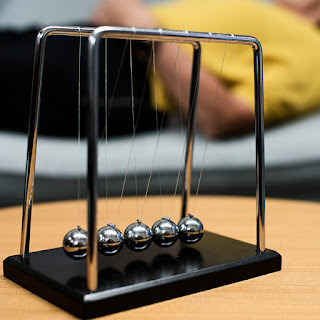
In the context of interior design, we delve into the idea of visual balance, where objects within a space coexist harmoniously, each carrying equal weight and significance. Neglecting this balance can result in the viewer's attention being fixated on one focal point, causing the rest of the space to be overlooked.
To address this, mastering the art of balance becomes imperative, and there are three fundamental types:
Symmetrical Balance or Formal Harmony
Symmetry, as the name suggests, revolves around an imaginary central line dividing objects. What lies on one side mirrors the other, creating a formal and predictable aesthetic. Symmetrical balance finds its place in modern bedrooms and living rooms, offering a clean and soothing ambiance.

Asymmetrical Balance or Informal Harmony
Asymmetry introduces an element of unpredictability, deviating from the mirrored precision of symmetrical balance. While objects on one side differ from the other, there exists synchronization and visual balance along the imaginary central line. This approach injects vitality into spaces, steering clear of monotony.
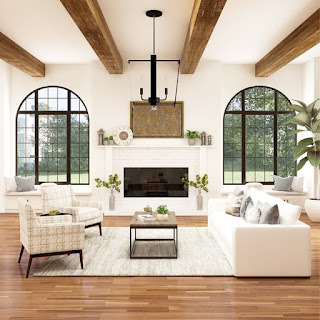
Radial Harmony
Tailored for circular objects, radial balance emanates from a central point, resembling the spokes of a wheel or the sun's rays. Circular tables surrounded by chairs or concentric circles on the ceiling exemplify this balance, creating a comfortable design for group settings.
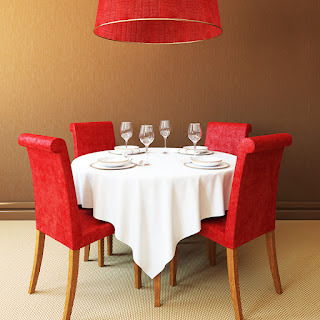
As we conclude this exploration of balance, stay tuned for the next chapter, where we unravel the captivating world of 'Rhythm' in our ongoing series. Acquire the skills, grasp the principles, and transform your living spaces into harmonious sanctuaries.
Ref. blog- https://interiorcourses.in/blog/know-how-to-restore-balance-in-your-home-office
#architect and interior designer anjali nandkumar#beginner interior design courses#interior decoration course online#online interior decoration course#online interior decoration course on udemy
0 notes